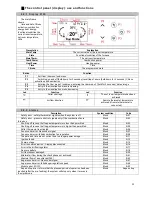
7
Min 3-5%
Ø80
Max 2-3m
If the floor is made of flammable material (e.g. hard wood), it is recommended to protect it by placing a layer of non-
flammable material under and around the stove.
For more information on the minimum safe distance from the flammable materials (see figure 2.2.a):
- Minimal distance from the flammable floor (F = 4 cm);
- Minimal distance from the flammable back wall (P = 20 cm);
- Minimal distance from the flammable side wall (L = 40 cm);
- Minimal distance from the flammable material on the front side (R = 80cm).
Once you've determined where you will set up the furnace, it is possible to adjust the legs that tilt the furnace to reach
the appropriate height.
back
side
side front
Picture 2.2.a:Distance at installation
Pipe characteristics
The main characteristics of the pipe are given below, in accordance with the requirements of the standard:
-
Inspection valve (I);
-
Maximum height of the pipe which is connected directly to the smoke outlet in the furnace should be between 2
to 3 m;
-
If you need a horizontal segment, ensure that it does not exceed 1.5 m in length and the inclination of 3 to 5% in
order to help extract the smoke;
Use the end portion that is resistant to wind and water to prevent the changing of conditions of slightly higher pressure
of the pipe (do not place the horizontal end at the end of the pipe);
Condition of somewhat greater pressure in the pipe is needed to facilitate the flow of smoke from the combustion
chamber.
Please note that any removal of excess heat is carried by the electric control part (modulation, shutting down, etc)
The exhaust duct must be made of materials that are resistant to combustion products and moisture (the review will
enable the removal of any moisture);
-
Ducts must be manufactured in such a way to prevent any leakage of smoke.
-
The duct must be isolated, especially the outer part which is exposed to atmospheric conditions.
Avoid using completely horizontal segments
Ø80
V>5m











































